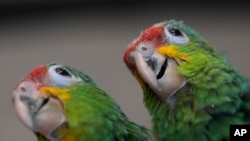Scientists from Australia and the United Kingdom are developing genomic sequencing technology to save parrots caught in the illegal wildlife trade.
They say their forensic methods are similar to a database used by INTERPOL, the international police organization.
Parrots are among the most trafficked birds in the illegal international wildlife trade.
By using samples from feathers or a speck of blood, researchers from the Australian National University and King’s Forensics in the United Kingdom are working to build a genetic database of threatened bird species.
They hope to create a DNA library that would help authorities track illegal trade routes and reveal the origin of animals seized from smugglers.
The research team says the genomic techniques are like those of INTERPOL’s I-Familia database, which is used to identify people based on international genetic kinship matching.
George Olah of the Fenner School of Environment and Society at the Australian National University’s College of Science told that threatened species of parrots need urgent protection.
He said generally, the illegal wildlife trade is the fourth most lucrative crime in the world.
“Like organized crime after arms trafficking, drugs and human trafficking,” he said. “Parrots are really prevalent in that trade that is in numbers of live animals. They are the most traded bird.”
Olah said genetic databases will be able to identify the source of smuggled birds.
“This would help, you know, local law enforcement agencies to better focus their limited budgets to these hotspots,” he said. “So, if you could work out that most of the trade in animals are coming just from a few islands, or from a specific region, then they can focus on that to actually break the chain.”
Olah will travel to Indonesia next month to meet with local authorities and researchers. He says the illegal parrot trade is rife in the Indo-Pacific nation.
Scientists say that in addition to being a threat to biodiversity, wildlife trafficking is an international public health issue because of its role in spreading zoonotic diseases.
The National Institutes of Health in the United States says these are “a disease or infection that can be transmitted naturally from vertebrate animals to humans or from humans to vertebrate animals. More than 60% of human pathogens are zoonotic in origin.”








